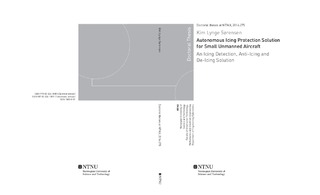| dc.description.abstract | This monograph is motivated by the lack of an autonomous icing protection solution for small unmanned aerial vehicles.
The atmospheric phenomenon commonly referred to as aircraft icing is one the most dangerous weather hazards to all of aviation. When an aircraft operates in atmospheric conditions that sustain icing, a potential of ice forming on exposed aircraft surfaces arises. The most significant of these surfaces are the leading edge of aircraft wings, stabilisers, and various control surfaces. This monograph focusses on icing as it forms on the leading edge of wings. The consequences of icing range from insignificant to dire, even fatal. For unmanned aerial vehicles, as is the case for conventional aircraft, the impact of icing primarily relates to controllability of the aircraft. Once icing forms on the wings the aerodynamic shape is altered. Typically this leads to changes in the aerodynamic characteristics of the wing, i.e. maximum lift can decrease by as much as 80% and drag can increase by more than 60%. For small unmanned aerial vehicles there are no commercially available icing mitigating solutions, aside from grounded operations. This monograph is a presentation of just such a solution. The icing protection solution is based on three primary elements, 1) an electro-thermal source, 2) an intelligent control unit, and 3) a power source. In essence the solution provides according to the following; the control unit is primed by an on-board atmospheric sensor package, measuring ambient environmental conditions. Once the risk of icing is established, two ice detection algorithms - working in parallel - are activated. This approach ensures robustness and accuracy. If icing is detected, control algorithms trigger the power supplied to the electro thermal source, thereby achieving temperature control of the thermal source.
For conventional aircraft, icing detection is usually performed by larger optical sensors or a pilots visual inspection. For UAVs icing detection is a relatively new research topic. In this monograph two markedly different approaches to icing detection for UAVs are proposed. Common for both is the objective of detecting icing as it forms on the leading edge of aircraft wings.
One icing protection solution presented in this monograph is denoted the modelbased icing detection algorithm. It addresses the issue in a fault diagnosis framework by generating residuals used to detect aircraft surface faults (that is aerodynamic changes), indicating that icing is forming on the leading edge of the aircraft wings. The proposed algorithm relies on estimates of aerodynamic parameters - obtained under nominal flight conditions - and the aerodynamic model of the aircraft. Should these parameters change unexpectedly a surface fault has occurred, i.e. icing is forming on the wings of the aircraft. The proposed algorithm has been validated through numerical analyses.
The second icing detection algorithm proposed is denoted the electro-thermalbased icing detection algorithm. It also addresses the issue of icing detection in a fault diagnosis framework, but where the prior algorithm uses the aerodynamic model of the aircraft to accomplish this, the latter algorithm applies a model of the thermodynamic system surrounding the aircraft wings and the electro-thermal source. The electro-thermal-based icing detection algorithm uses temperature gradients, obtained from the electro thermal source, and unexpected changes in these to detect changes in the thermodynamic system. A change could be an added element as a layer of ice. The proposed approach has been validated through a simulation study.
To evaluate the electro-thermal source layout and area size, several thermodynamic analyses are conducted. Simulations are conducted to determine the relationship between area size and power consumption, while responses from other simulations are used to investigate and evaluate the thermal distribution differences of electro-thermal sources applied to various UAV platforms.
To demonstrate the feasibility of the proposed icing detection solution wind tunnel experiments and flight tests have been conducted. Preliminary integration procedures are developed to ensure little to no negative aerodynamic impact, while abiding by requirements for airworthiness and safe flight operations.
Wind icing tunnel experiments have been conducted for various required icing protection program routines, i.e. icing detection, de-icing, and anti-icing. Experiments have been conducted in atmospheric conditions ranging from non-icing to varying severity degrees of icing.
Preliminary flights include the worlds first flight for any UAV fitted with an autonomous icing protection solution, completed in a collaboration between NTNUAMOS and NASA Ames Research Center and conducted in Anchorage, Alaska.
Operational flights have been conducted at Ny Ålesund, Svalbard, where the aforementioned icing protection program routines have been tested, verifying the icing protection solution. | nb_NO |
